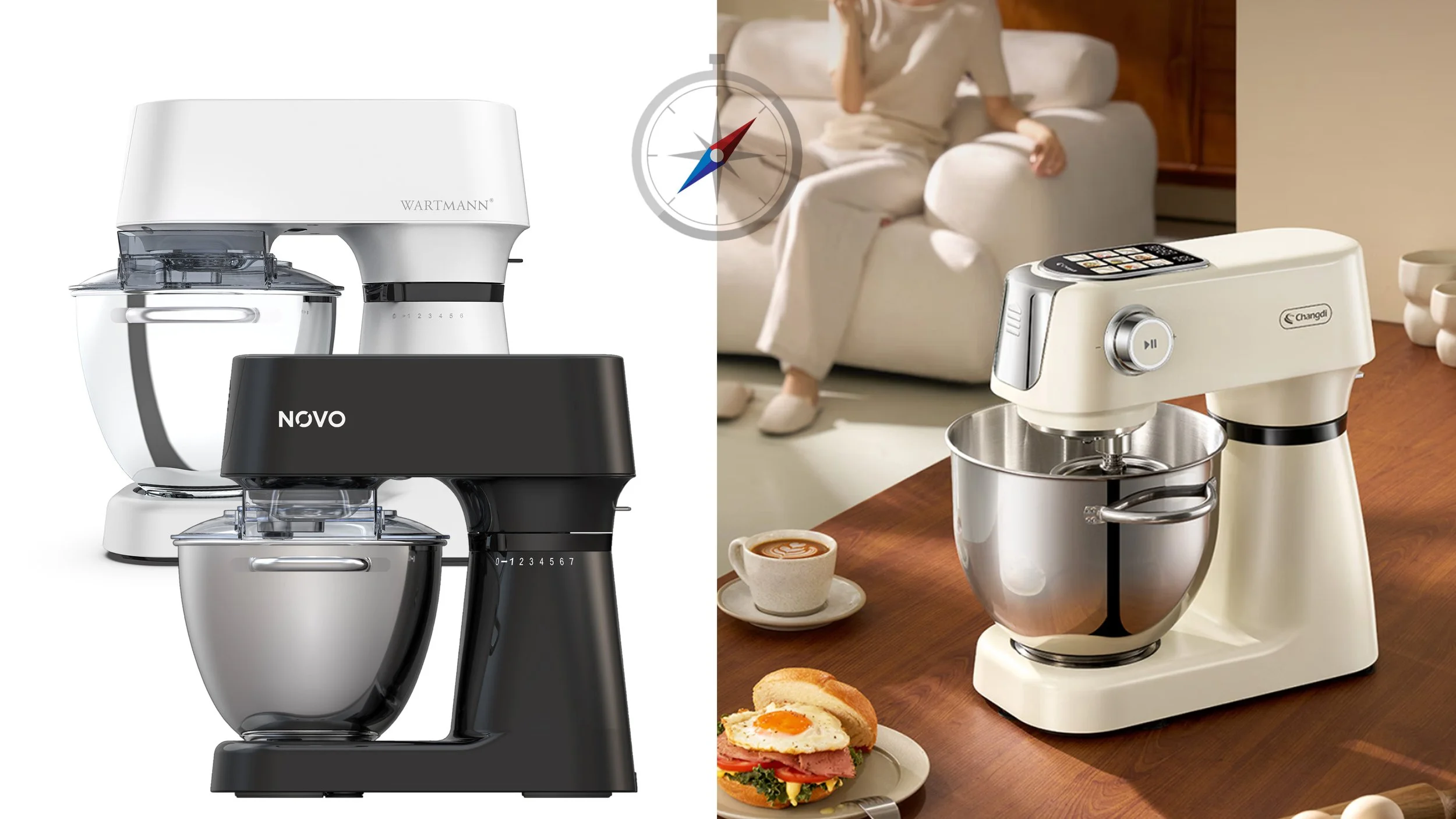Design across cultures.
When a Project Travels.
Every design project begins with a set of clear intentions, but its real story often starts when it leaves the designer’s hands. Products travel, evolve, and sometimes take unexpected directions. They adapt to different markets, to different ways of living and thinking, revealing how design is never static but always in motion.
This story begins with a stand mixer designed for Assiduous, a project born to combine precision, proportion, and usability into a single coherent form. What started as a design exploration in Italy and China soon became a case study in how ideas migrate across cultures, transforming while keeping their essence intact.
A few years after its launch, that same product reappeared in a new context under a new name and a new brand. The project had crossed borders, not only geographically but culturally, showing how a single design can embody multiple interpretations.
That is where the title of this article comes from, “Same origin, different directions”, because what makes this story interesting is not just the product itself, but the way two different worlds have reimagined it according to their own aesthetic and cultural values.
The design of the concept.
The collaboration with Assiduous started with a clear goal: to create a product that would look and feel precise, proportioned and effortless. From the very beginning the design process focused on balance, both visual and functional, translating technical constraints into a form that communicates calm and control.
The stand mixer was built around a distinctive idea, a ring-shaped interface integrated into the front display area. Instead of a conventional knob, the ring allowed the user to control speed and time with a simple circular gesture. This detail became the signature of the product, a gesture-driven solution that blended interaction and identity.
Formally, the design followed a logic of continuity. The head and body were conceived as a single flowing volume, with no abrupt transitions and no unnecessary accents. Every element was defined by its function, yet composed to maintain visual harmony. The result was a product that looked solid but light, expressive yet rational.
Color and finish were part of this same philosophy. The Western version explored pure tones, mainly white and black, with a matte surface that reduced reflections and emphasized the precision of the geometry. The texture absorbed light rather than projecting it, reinforcing the sense of quiet confidence that defined the product.
This approach reflected what could be described as a Western sense of clarity, where precision and restraint are perceived as signs of quality. The interface does not ask for attention; it invites use. The geometry does not compete with the environment, it complements it. In this sense, the design expressed what we often call quiet performance: an attitude rather than a style.
Over time, the project proved its relevance. The same design was later commercialized in Europe under the Wartmann brand and in the Middle East under NOVO, confirming its adaptability and the strength of its original identity.
The ChangDi Reinterpretation.
When the design was later acquired by ChangDi, one of China’s leading appliance brands, it entered a new phase of its story and it needed to be reinterpreted. The product was not simply reproduced, it was translated into a different language, one that reflects the visual codes and expectations of the Eastern market.
The original balance of proportions and silence was replaced by a more expressive composition. The smooth, continuous head hosted now a large digital display on the upper plane, while the circular interface was substituted with a rotary knob positioned on the side. These choices immediately changed the interaction, transforming a minimal, tactile experience into a more extroverted, screen-based one.
This transformation also extended to color and surface treatment. The neutral matte finish of the Assiduous model gave way to a glossy cream tone, warmer and more decorative, evoking a subtle sense of vintage appeal. The reflective surface catches light and movement, adding a touch of softness and familiarity that resonates with the domestic aesthetic of the Eastern market.
ChandDi’s version on JD.com
This evolution reveals more than a change in style, it reflects a difference in cultural perception. In Western design, clarity and control are often conveyed through reduction and neutrality. In many Asian markets, instead, technology and comfort are expressed through visual richness and warmth. The display becomes a stage where functionality is celebrated, while the color and shine contribute to a sense of presence and emotional connection.
By introducing a more articulated interface and a softer chromatic character, the ChangDi version addresses an audience that values perceived intelligence and visual engagement. The result is not a contrast but a reinterpretation, a design that speaks with a different voice while keeping the same structure.
Beyond Differences.
Beyond its commercial journey, this project tells something essential about design itself. Every product carries within it a cultural code, a set of values that can either remain fixed or evolve when exposed to different contexts. What happened with this stand mixer is not a case of imitation, but a demonstration of how design adapts, not only to production systems, but to habits, aesthetics, and perceptions.
In the contemporary Western version, the language of design is rooted in control and understatement. The form must express precision, the interface must guide the gesture, and the color must support the object without dominating it. Everything is calibrated to create a sense of trust, clarity, and durability.
In the Eastern reinterpretation, the same structure becomes a platform for a different sensibility. The focus shifts from restraint to experience, from purity to expression. The product speaks to the user through light, contrast, and a touch of spectacle. It is no longer just about efficiency, but about presence, about making the object part of an emotional landscape.
Neither of these perspectives is right or wrong. They simply reveal two ways of giving meaning to technology. One relies on silence, the other on expression. One hides the mechanism behind a disciplined form, the other amplifies it through visual interaction.
For a designer, understanding these nuances means working with awareness rather than style. It means realizing that the same geometry can embody opposite values depending on where it lands. This is perhaps the most challenging and fascinating aspect of global design today: creating something specific enough to have character, but flexible enough to belong anywhere.
A Cultural Compass
Every project teaches something, but only a few continue to evolve after leaving the studio. This one did. Seeing it reappear under a different name, with different colors, materials and interfaces, inevitably felt like watching it move away from its original intent. The design had been transformed, almost distilled into another logic. Yet, in that transformation, I could also recognize its reason.
The Assiduous mixer was born from an idea of proportion and precision, conceived for a market that values coherence and subtlety. The ChangDi version, instead, responds to a new positioning, where visibility, technology and communication define the product’s identity as much as its performance. What once spoke through silence now speaks through presence, and that is a legitimate evolution.
The compass placed between the two versions represents more than a geographic distance. It marks the trajectory of a design that has crossed not only borders, but meanings. North and South, East and West, are not opposing poles, they are different interpretations of the same origin.
So yes, the project has changed, perhaps even been distorted in its language, but in doing so it has revealed how design adapts to survive. This is what keeps it alive, not as a static object but as a narrative that continues through markets, users and time.
In the end, that is what I call real design; when an idea evolves beyond control, shaped by context rather than authorship, and continues to speak in many voices while keeping one soul.
Western and Asian version comparison



